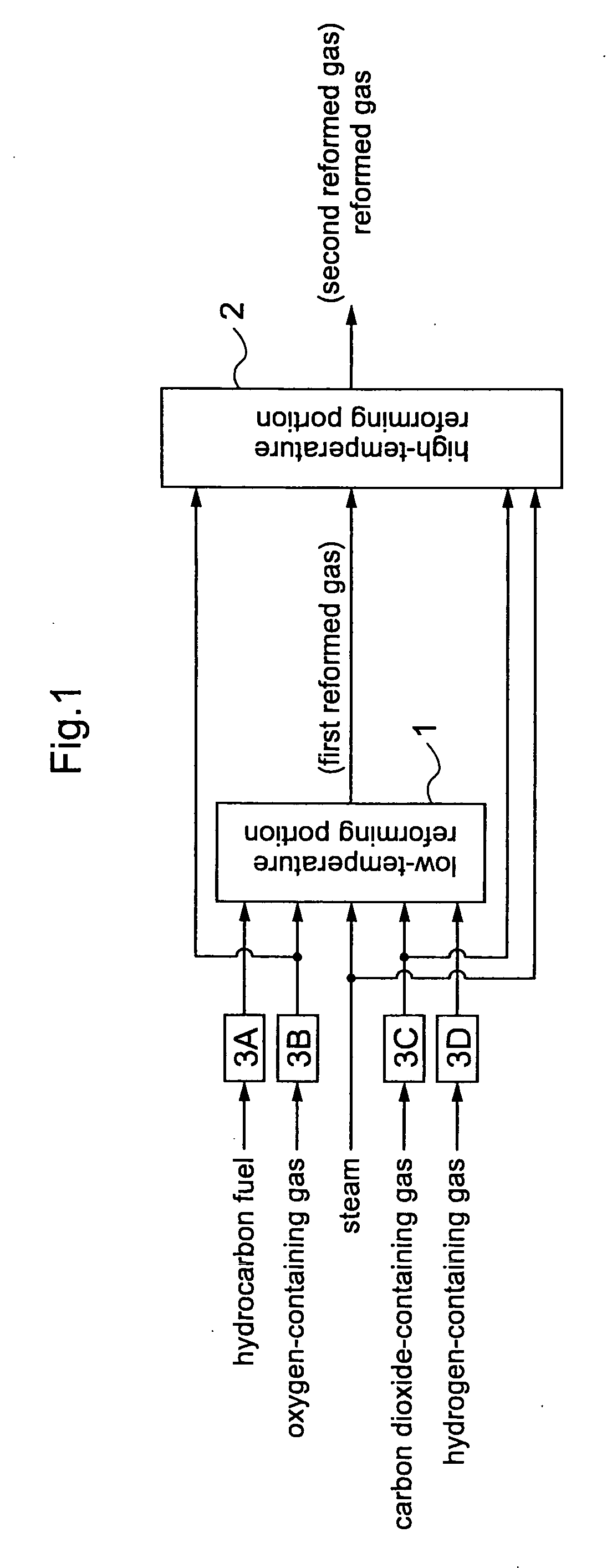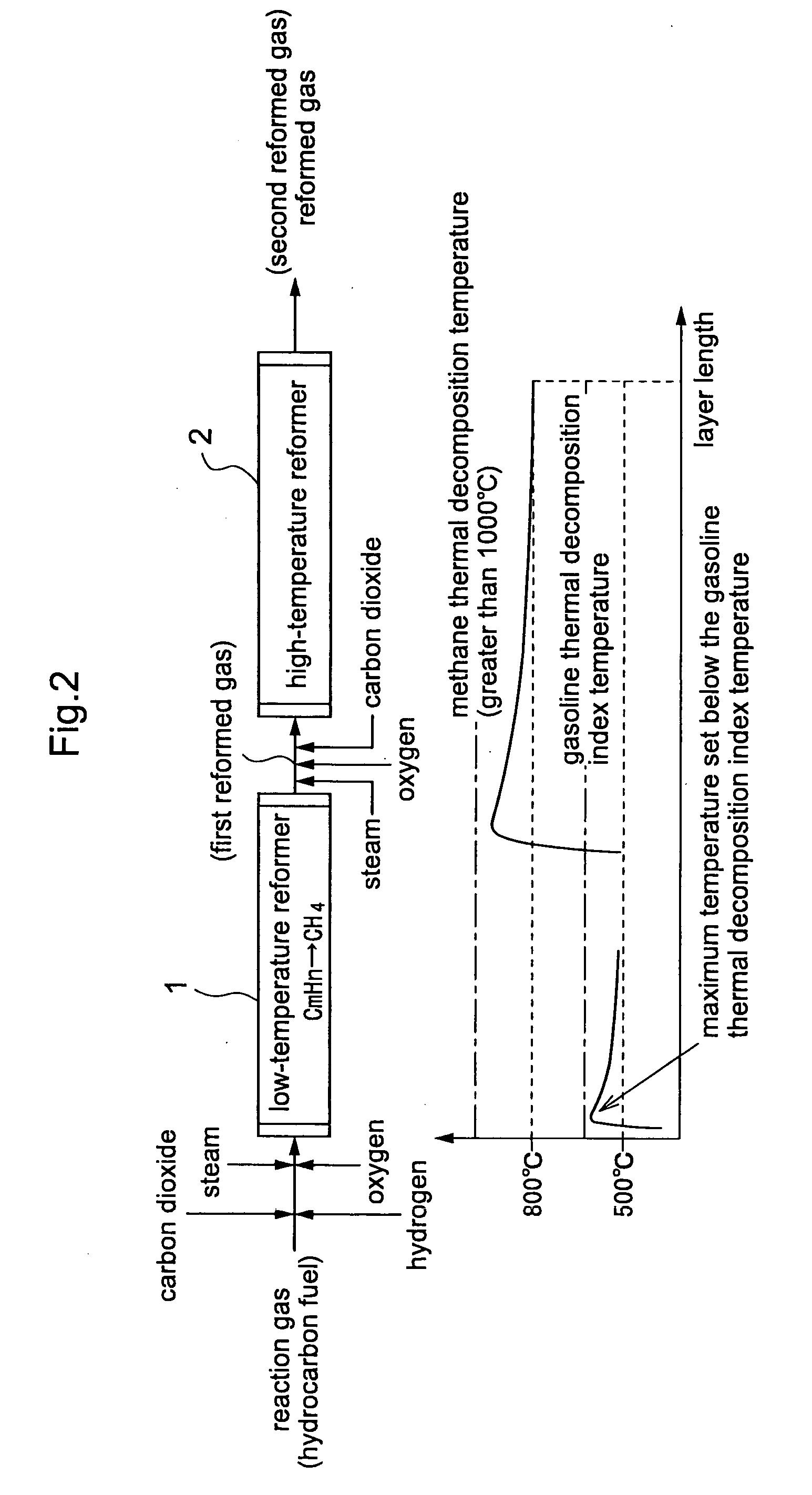Reformed Gas Production Method and Reformed Gas Production Apparatus
a gas production method and gas production apparatus technology, applied in the direction of sustainable manufacturing/processing, bulk chemical production, final product manufacturing, etc., can solve the problems of large catalyst requirements, inability to provide compact reformers, and preventing stable use of apparatuses
- Summary
- Abstract
- Description
- Claims
- Application Information
AI Technical Summary
Benefits of technology
Problems solved by technology
Method used
Image
Examples
working example 1
Activation of the Reforming Apparatus when the Fuel Gas is Propane
[0120]The characteristics of the rise in temperature due to the catalytic combustion of hydrogen were measured to assess the activation state. The microreactor 4A was filled with 33 mL of a ruthenium-based reforming catalyst Ru / Al2O3 (2 wt % Ru / alumina substrate, particle diameter: 0.5 to 1.0 mm). The other conditions were: propane (C3H8) supply rate 176 mL / min, hydrogen supply rate 158 mL / min, and oxygen supply rate 79 mL / min. When the mixed gas of hydrogen, oxygen, and propane was introduced at room temperature into the reactor 4 under these conditions, the catalyst-mediated hydrogen combustion reaction heated the catalyst-filled layer, raising its temperature. FIG. 4 shows the characteristics of the rise in the temperature of the catalyst-filled layer inlet at this time, and after approximately 40 minutes it had reached 400° C. (suitable operating temperature).
[0121]It should be noted that during this operation, th...
working example 2
Reforming Propane with a Ruthenium-Based Catalyst
[0122]The partial oxidation and steam reforming reactions of propane gas were performed using the same apparatus as that of Working Example 1. In this experiment, air was used as the oxygen-containing gas.
[0123]The experiment conditions were as follows.
catalystruthenium supported on aluminacatalyst fill amount3.3 mLfill height1.0 cmreaction gaspropane + air + steamO2 / C (mole ratio)0.3 to 1.4S / C2.5SV10000 h−1inlet temperature300° C.
[0124]FIG. 5 shows the experiment results when, at SV=10000 h−1 and a Tin of 300° C., the O2 / C ratio is altered over a range of 0.3 to 1.4 and S / C is changed to 2.5.
[0125]The results of the experiment indicate the following.
[0126]The greater the O2 / C ratio, the higher the maximum temperature Tmax within the catalyst layer, which is the reforming reaction region, and the catalyst layer outlet temperature Tout are with respect to the inlet temperature Tin. As a result, it was clear that it is possible to contr...
working example 3
Reforming Propane With a Nickel-Based Catalyst
[0129]Using a nickel catalyst Ni / Al2O3 (nickel concentration 22 wt %, alumina substrate) in lieu of a ruthenium-based catalyst, propane gas was subjected to partial oxidation and steam reforming using the same apparatus as that of Working Example 1. The experiment conditions and results are shown in FIG. 6. It is clear that propane gas is stably reformed into hydrogen and methane, for example.
[0130]It should be noted that after being loaded into the microreactor, the Ni catalyst was reduced for one hour at 400° C. by nitrogen gas that included 10% hydrogen.
[0131]After the reaction, the reactor was returned to room temperature, dismantled and examined, and carbon deposition was not found to have occurred inside the reactor or on the catalyst surface.
PUM
 Login to View More
Login to View More Abstract
Description
Claims
Application Information
 Login to View More
Login to View More - R&D
- Intellectual Property
- Life Sciences
- Materials
- Tech Scout
- Unparalleled Data Quality
- Higher Quality Content
- 60% Fewer Hallucinations
Browse by: Latest US Patents, China's latest patents, Technical Efficacy Thesaurus, Application Domain, Technology Topic, Popular Technical Reports.
© 2025 PatSnap. All rights reserved.Legal|Privacy policy|Modern Slavery Act Transparency Statement|Sitemap|About US| Contact US: help@patsnap.com



